Looking for the best flea treatments for a husky? We’ve got you covered.
As dog owners we’ve all been there.
You come back from a nice walk with your pooch, settle down to relax and all of a sudden you notice that your furry friend is scratching and just won’t stop.
Fleas are a common problem, and if left untreated can cause skin infections, hair loss, and general discomfort for your dog. Huskies are particularly prone to flea infestations thanks to that lovely thick and long fur – which unfortunately makes a rather inviting home…
Humans can also suffer the odd itchy bite too, and if your home becomes infested it can be very difficult to eradicate those pesky parasites.
If you think your dog my have a flea problem, it’s crucial to act quickly to stop the problem becoming worse.
There are many effective flea treatments available — so let’s get started!
The Best Flea Treatments for Dogs
K9 Advantix II Flea, Tick and Mosquito Prevention
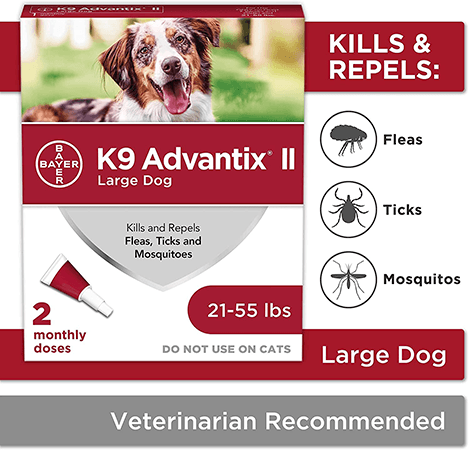
This topical flea treatment for dogs by Bayer Animal health provides prevention and treatment of ticks, mosquitos and other parasites and biting flies as well as fleas.
Importantly, the K9 Advantix II repels and kills all life stages of fleas, offering total protection from flea infestations and mosquitos for a period of 4 weeks.
This powerful spot-on flea treatment starts killing instantly, and can effectively kill all fleas that come within contact of the infested dog within 12 hours.
K9 Advantix II Flea is suitable for adult dogs and puppies aged more than 7 weeks.
Pros
- Recommended by veterinarians
- Works on all flea life stages
- Waterproof
- Effects last for 30 days
- Also effective against mosquitos and other parasites
- Starts working extremely quickly
Cons
- Quite expensive
Frontline Plus Flea and Tick Control
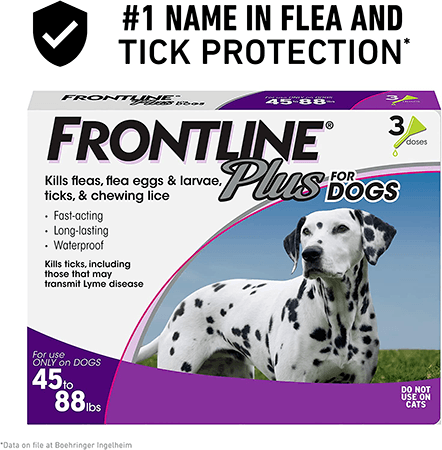
Frontline Plus Flea and Tick Control for Dogs and Puppies targets and kills all life stages of ticks, chewing lice and fleas in the egg, larval and adult stages thanks to the formula containing two active chemical ingredients which disrupt the reproductive cycle.
The highly effective, fast acting topical formula comes as an easy to apply pipette, and has effective results for at least 4 weeks following application on your husky.
Suitable for dogs of more than 8 weeks old, this flea treatment for dogs promises to kill all fleas within 18 hours.
Pros
- Effective even if your dog gets wet (ideal for our huskies given they are VERY active!)
- Kills fleas in all stages of development
- Also effective against ticks and chewing lice
- Fast – begins killing fleas in 2-4 hours and ticks in around 12 hours
- Provides ongoing protection for 30 days
Cons
- Quite expensive
Vet’s Best Flea and Tick Home Spray
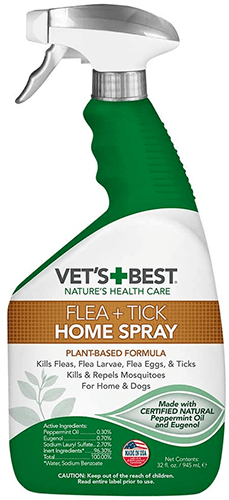
Instead of using harsh chemicals, Vet’s Best Flea and Tick Home Spray for Dogs and Home relies on purely plant based ingredients and essential oils to kill fleas, ticks, and flea eggs, plus repel mosquitos. That’s right, it’s a natural flea treatment for dogs!
These specially chosen oils act to disturb the nervous systems of parasites, eventually causing their bodies to shut down and die.
This flea treatment spray can be used either directly on your pet, as well as soft furnishings and carpets in the home, and to treat yard areas.
Pros
- Totally natural product
- Versatile protection for both dog and home
- Doesn’t stain
- Pleasant odor
- Environmentally friendly
- Safe to use around children
Cons
- Must be applied regularly
- A little less effective and reliable than chemical products
Seresto Flea and Tick Collar
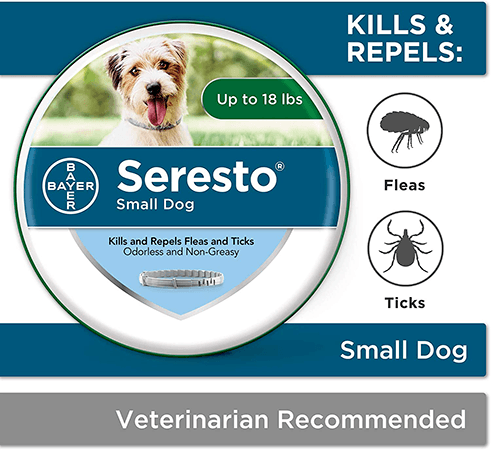
Offering up to 8 months protection from fleas and ticks, the bestselling Seresto collar for dogs kills and repels ticks, adult fleas and flea larvae. It also repels mosquitos, and helps to prevent heartworm.
And it manages to do all that using an organic, non-toxic formula that starts working within just 24 hours.
The collar itself comes in two sizes for adult dogs and puppies over 12 weeks old, and is totally waterproof. The small size fits dogs up to 18 pounds, whilst the large collar works for dogs over 18 pounds with a neck size of between 20 to 23 inches.
Whilst this flea product boasts an impressive 8 months of protection, it should be noted that bathing your dog more than once per month will reduce the effectiveness and duration of the protection.
For example, a dog that swims and has more than 1 bath per month would likely receive only around 5-6 months of protection.
Pros
- Effective against fleas and ticks
- Long lasting
- Easy to put on and take off
- No unpleasant odor
- Free from chemicals
- Waterproof
- Well made
Cons
- Collar may need to be cut to size
- Too many baths may reduce the effectiveness
Adams Plus Flea & Tick Shampoo with Precor for Dogs
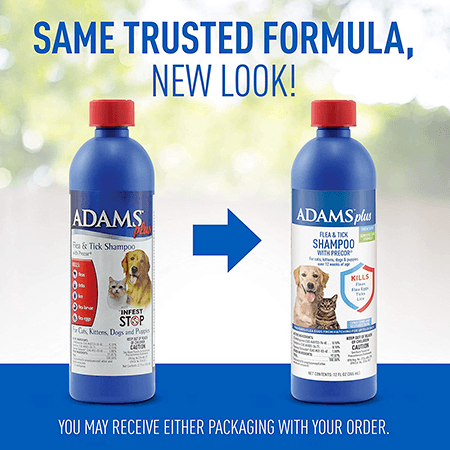
Perhaps the best flea shampoo for dogs on the market, Adams Plus contains pyrethrins which kill fleas at all stages in their life cycle, as well as natural ingredients such as aloe and oatmeal which are gentle on sensitive skin and promise to give your dog a glossy coat.
Offering protection against fleas and ticks for up to 28 days, this is a powerful and long lasting flea shampoo formula which can be used on puppies over 12 weeks of age, and adult dogs.
Pros
- Soothes irritated skin and removes build up
- Effective protection against fleas for up to 4 weeks
- Conditions coat
- Inexpensive
- Kills flea eggs, larvae, and adults, as well as ticks
- Works up into a nice, thick lather
Cons
- Has strong odor that some huskies won’t like
Effective Flea Treatments for Huskies
Common Ingredients
Most flea treatments use chemicals called pyrethrins (which occur naturally in certain plants) or pyrethoids (a lab synthesized version of pyrethrins), which disrupt the normal function of an insect’s nerve cell, resulting in paralysis and ultimately death.
This is ideal for killing fleas in their adult stage.
Other common chemical ingredients are Permethrin, Imidacloprid and Lufenuron, which halt flea egg and larvae development by rendering adult fleas sterile — thus interrupting the reproductive stage in the flea life cycle and preventing new fleas hatching.
The best flea treatments for dogs include chemicals that attack multiple stages of development in the flea life cycle.
However, if your preferred treatment only treats one stage, it may be possible to combine it with another type of flea treatment which attacks another stage, in order to make the overall flea treatment more effective.
Treatment Types
Flea treatments for dogs come in many different types, and some are more effective than others. So what is the best flea treatment for dogs?
Here’s a good primer on the different flea and tick medication available:
In the end it comes down to personal preference and the individual dog. Here’s our guide to the different types of flea treatment for dogs…
Topical Treatments
These are small pipettes full of liquid which are applied directly to the dog’s skin, usually at the base of the neck where they can’t reach round to lick or scratch the area where the product has been applied.
The liquid contains potent flea killing chemicals which are distributed all over the dog’s body, and which release their active ingredient slowly over time to give long lasting protection.
Dosage is dependent on the dog’s weight, with larger breeds (like a husky) needing a bigger dose, and the treatment generally remains effective for 4 weeks — with some lasting longer.
The best topical flea treatment for dogs is usually a prescription product from a veterinarian, as these tend to be more effective than cheaper, store bought brands.
Pros
- Quick and easy to apply
- Effective – kill most fleas within a few hours of application
- Often includes additional protection against ticks and other parasites
- Fairly long lasting
Cons
- Dog must stay dry for at least 24 hours after application
- May cause allergic reactions
- Can be expensive
Oral Treatments
Usually available in soft tablet form, oral treatments work by putting flea killing chemicals into the dog’s bloodstream which are then transmitted via the skin when a flea bites, although some products are released via the pores of the skin.
Some oral treatments attack and kill adult fleas, while the best oral flea treatment for dogs may not kill the fleas directly, but instead prevent them from spreading by rendering them sterile and incapable of laying fertile eggs.
Treatments that merely kill the adult fleas tend to be effective over the course of around 24 hours, whereas those that also target eggs and larvae can remain effective for up to 1 month.
Pros
- Effective at preventing flea reproduction
- Easy to administer
- No need to worry about stopping your dog from getting wet
- Can be used in combination with other types of flea treatment
Cons
- May cause allergies or stomach upsets
- Does not kill ticks
Flea Collars
Another common type of flea treatment, flea collars are impregnated with concentrated anti-parasitic chemicals that act to repel fleas as well a killing any fleas that are on the dog’s body.
These chemicals are sometimes absorbed into the skin of the neck for additional protections against fleas. Flea collars can remain effective for many months depending on the brand, but their efficacy reduces over time, particularly if your dog frequently gets wet.
Worn alongside the dog’s normal collar, flea collars should never be attached to a lead as they are likely to snap.
Pros
- Easy to use for dog owners who don’t like giving oral medications or applying regular skin treatments
- Very long lasting (usually up to 6 months)
- Less expensive than oral or topical treatments
Cons
- Thought to be less effective than oral or topical treatments
- Can have a strong chemical odor
- May irritate the dog’s skin
Flea Sprays
Less commonly used in the war against fleas than other flea treatments for dogs, flea sprays contain a chemical solution that can be applied directly to the skin and fur of your pet.
Flea sprays kill fleas on contact, but most only kill adult fleas and the effects are not long lasting (normally only one or two days) with regular, repeat applications being necessary.
Pros
- Convenient for quick treatment – after a walk for example
Cons
- Product may be licked off by dogs and ingested
- No ongoing preventative protection against fleas
- Dog must stay dry for product to be effective
Flea Shampoos
Used to wash away adult fleas and flea eggs, flea shampoos may also contain active ingredients which kill adult fleas.
Flea shampoos need to be massaged into the skin and fur and left for around 15-20 minutes to be effective.
While flea shampoos can be fairly effective at killing adult fleas the effects only last a couple of days, after which time a repeat treatment is necessary.
Read more: the best flea shampoos for huskies
Pros
- Effective when used in combination with other flea treatments
- May also kill ticks
- Affordable
Cons
- Bathing your dog is time consuming
- Effects are short lived
Understanding the Flea Life Cycle
When treating your dog for fleas, it’s important to understand the flea life cycle.
The entire cycle, from egg to adult flea, is complete in 12 – 22 days when temperature and humidity conditions are ideal, but more commonly takes 3 – 4 weeks.
There are 4 main stages in the development of a flea:
Egg
Adult female fleas lay eggs directly on the skin or fur of the host animal (in this case your pup) following a large meal of blood.
Eggs are white in color and very tiny — smaller than a grain of sand — so difficult to spot.
A single adult female can lay about 40 eggs every day, and these eggs usually fall to the ground to contaminate your home and garden environment.
Flea eggs ideally require warm, humid temperatures to hatch quickly, and with optimum conditions will hatch after only a few days.
Larvae
When flea larvae hatch from the eggs they are are still very small with a length of only a few millimeters.
They are almost transparent and totally blind, and they survive and grow by eating a mixture of pre-digested blood in the form of droppings from adult fleas, their own skin sheddings, and various other organic debris that they find in the environment such as skin cells and hair.
Flea larvae don’t like light, so they will often seek out dark areas such as under furniture and ped bedding.
After 5 – 14 days, the larvae are well developed enough to go on to the next stage in their life cycle.
Pupae
The larvae spin themselves a protective cocoon in which they will undergo the transformation to an adult flea.
This white colored cocoon has a sticky surface, which glues itself to carpet fibers and other debris, making it very hard to budge — even with a vacuum.
Pupae require a warm environment, and in ideal conditions the adult flea can emerge from the pupa after only 8 – 12 days.
However, if conditions aren’t ideal, flea pupae can lie dormant for anything up to a couple of years, which is why dog owners often find fleas in the home after winter when the weather warms up allowing the dormant pupae to hatch.
Adult
The final stage of the flea life cycle is the adult stage. Adult fleas emerge as small dark brown insects a few millimeters in length.
They have powerful back legs which allow them to hop onto passing dogs, after which they will almost immediately begin feeding on the animal’s blood.
Their mouthparts are adapted for piercing skin and sucking blood, and special properties in their saliva ensure that there the blood won’t clot before they have finished their meal.
It is this saliva which can be the cause of flea allergies in sensitive dogs.
Adult fleas stay on the host body for several weeks or months, feeding, breeding and laying eggs to provide the net generation of pesky parasites.
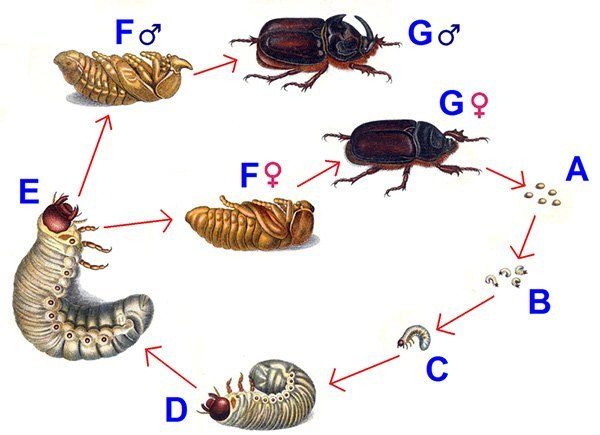
With this information in hand, it’s easy to see just how resilient fleas can be.
This is why it is not always enough to just target fleas at one particular stage of their life cycle.
From experience, what do you think is the best flea treatment for dogs?
